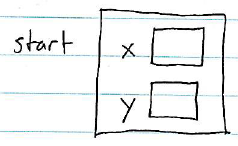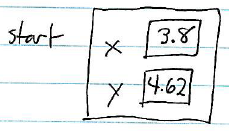Struct types allow us to define new data types in our programs. We can use functions to define operations on struct types, leading to an extremely powerful programming technique called encapsulation.
Motivation for defining new data types
Let's say we're writing a program that is going to work with two-dimensional geometrical data. One important kind of data the program will manipulate is points. A point is two values:
- an x-coordinate
- a y-coordinate
One way to represent a point is as two variables. For example, let's say that we have a point representing a starting location. We could define variables to represent the point as follows:
double startX;
double startY;This point representation works, but it's awkward. Each point represented in our program is represented by two variables. Let's say we extend the program to work with three-dimensional data. Now we need three variables for each point, e.g.:
double startX;
double startY;
double startZ;Another way in which we can see the awkwardness of using multiple variables to represent a point is when we write functions to perform operations on points. For example, we might want to write a function to compute the geometric distance between two points. For two-dimensional points, this function would require four parameters, two for each point:
double geometricDistance(double point1X, double point1Y, double point2X, double point2Y)
{
double xDist = point1X - point2X;
double yDist = point1Y - point2Y;
return sqrt((xDist * xDist) + (yDist * yDist));
}If we change the program to support three-dimensional data, now this function needs six parameters. Blech!
Struct types
A struct type defines a new data type as some number of fields.
For example, we could define a struct type for two-dimensional points as follows:
struct Point {
double x;
double y;
};The Point struct type has two fields:
- a double field named x
- a double field named y
That means that each instance of the Point type has two values, x and y, both of which are doubles. A definition of a struct type is a "template" that specifies what data is contained in instances (variables) of the type.
Struct instances
Once you have defined a struct type in a program, it can be used to declare instances of the type. E.g.:
struct Point start;This declaration defines the variable start as an instance of the Point data type.
You can think of variables that have struct types as "bundles" of variables glued together. Each field defined in the struct type becomes a variable in each instance of the struct type.
It is helpful to visualize struct instances as boxes containing "nested" boxes representing fields: e.g.,
Accessing fields
The field variables located within each struct instance can be accessed using the member selection operator, denoted by a period (".").
For example, we could use the following code to initialize the start instance declared above, storing values in each of its fields:
// set start point to x=3.8, y=4.62
start.x = 3.8;
start.y = 4.62;After this code executes, we can visualize the start instance like this:
Its x and y fields have now been set to the values 3.8 and 4.62, respectively.
The member selection operator can also be used to retrieve the value of a field inside a struct instance. For example, we could print the contents of the start instance:
printf("start: x=%lf, y=%lf\n", start.x, start.y);Struct types + functions = encapsulation
The real power of struct types becomes apparent when they are used in conjunction with functions. The idea is that we can write functions to perform operations - i.e., computations - on instances of struct types.
For example, the function to compute the geometric distance between two points could be defined as:
double geometricDistance(struct Point point1, struct Point point2)
{
double xDist = point1.x - point2.x;
double yDist = point1.y - point2.y;
return sqrt((xDist * xDist) + (yDist * yDist));
}Using struct types and functions together in this way is called encapsulation, because the struct type and the functions that operate on its instances "encapsulate" a concept that is important in the program. Together, the struct type and its operations (functions) make your programs more expressive and easier to understand because both data and operations on data are given meaningful names. E.g., when we see the code
struct Point start;it is clear that start is a point. Likewise, when we see the code
struct Point start, end;
...
double tripDistance = geometricDistance(start, end);it is clear that the distance between two points called start and end is being computed.
Encapsulation makes the program easier to understand and change
Let's say that we've written a program to do computations on two-dimensional points using a Point struct type and functions to perform operations on Point instances.
To update the program to work with three-dimensional points, we would need to do the following:
- add a z field to the Point struct type
- change the code of functions such as geometricDistance to take the additional dimension into account
Assuming that all of the code that does computations on instances of the Point type is written to call functions such as geometricDistance, instead of doing to computations directly (by accessing the fields), then
no additional code changes are needed
This advantage of struct types and functions---making programs easier to change---is very significant for large and complex programs.


